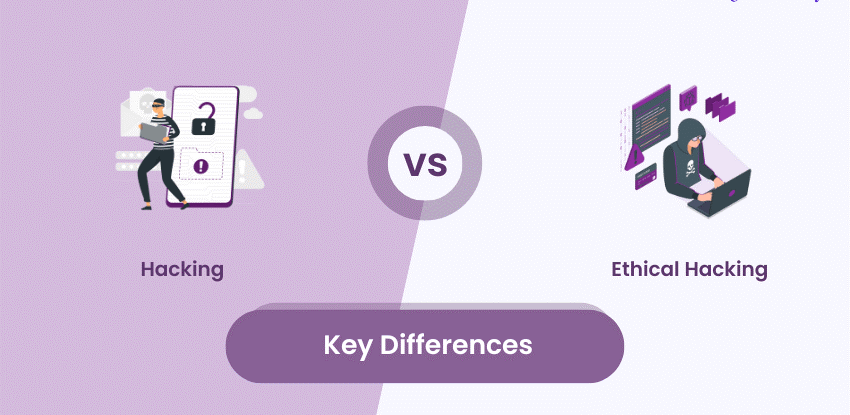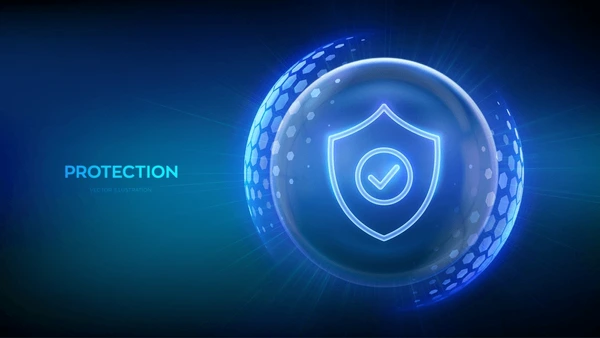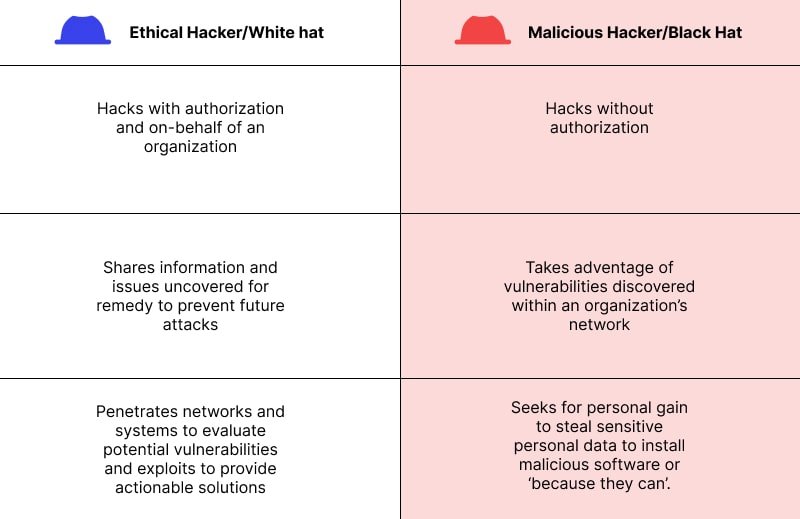Hacking is a term that often carries a negative connotation, but not all hacking is harmful. Ethical hacking and malicious hacking represent two sides of the same coin, utilizing similar techniques but for vastly different purposes. In this blog, we will explore the distinction between ethical hacking and malicious hacking, their roles, and their impacts on the digital world.

What is Ethical Hacking?
Ethical hacking, often called “white-hat hacking,” refers to the practice of identifying vulnerabilities in computer systems and networks to enhance security. Ethical hackers use their skills to protect organizations from cyber threats.
Key Features of Ethical Hacking:
- Goal-Oriented: The main goal is to secure systems by identifying and fixing vulnerabilities.
- Authorized Activity: Ethical hackers operate with legal permissions from the organization.
- Techniques Used: Includes penetration testing, vulnerability assessments, and ethical exploits.
Ethical hackers play a crucial role in safeguarding sensitive data, financial information, and overall organizational security.

What is Malicious Hacking?
Malicious hacking, also known as “black-hat hacking,” involves unauthorized access to systems and networks for illegal purposes. These hackers exploit vulnerabilities to cause harm or gain unauthorized benefits.
Key Features of Malicious Hacking:
- Illegal Activity: Malicious hacking is a criminal offense punishable by law.
- Motivations: Often driven by financial gain, political agendas, or personal vendettas.
- Techniques Used: Includes malware deployment, phishing, and DDoS attacks.
Malicious hackers pose significant threats to personal and organizational cybersecurity, often leading to data breaches, financial losses, and reputational damage.

Ethical Hacking vs Malicious Hacking: Key Differences
Purpose
- Ethical Hacking: To protect systems and improve security.
- Malicious Hacking: To exploit systems for illegal or harmful purposes.
Legality
- Ethical Hacking: Conducted with proper authorization and legal frameworks.
- Malicious Hacking: Unauthorized and considered a criminal activity.
Tools and Techniques
- Both types of hackers often use similar tools, but the intent behind their use distinguishes them.

Common Techniques Used in Hacking
Ethical Hacking Techniques:
- Penetration Testing: Simulating attacks to identify vulnerabilities.
- Social Engineering: Testing user awareness and susceptibility to attacks.
- Network Scanning: Mapping and analyzing network weaknesses.
Malicious Hacking Techniques:
- Phishing: Deceiving individuals to steal sensitive information.
- Malware Deployment: Installing harmful software to disrupt operations.
- Exploiting Zero-Day Vulnerabilities: Using unknown flaws for attacks.
Importance of Ethical Hacking in Cybersecurity
Ethical hacking is a cornerstone of modern cybersecurity. It helps organizations:
- Identify vulnerabilities before malicious hackers can exploit them.
- Ensure compliance with regulatory standards.
- Build trust with customers and stakeholders by maintaining robust security.

Real-World Examples
Successful Ethical Hacking Cases:
- Bug Bounty Programs: Companies like Google and Facebook pay ethical hackers to find vulnerabilities.
- Preventing Ransomware Attacks: Ethical hackers thwarting planned attacks by identifying security gaps.
Malicious Hacking Incidents:
- Equifax Data Breach: Compromising sensitive information of millions.
- WannaCry Ransomware Attack: A global attack that caused billions in damage.

Conclusion
Understanding the difference between ethical vs malicious hacking is essential in today’s digital age. Ethical hackers are the guardians of cybersecurity, using their skills to protect systems and data. On the other hand, malicious hackers exploit vulnerabilities for personal or financial gain, causing harm to individuals and organizations alike.
Promoting ethical hacking and raising awareness about cybersecurity can help combat the threats posed by malicious hacking, ensuring a safer digital future.

